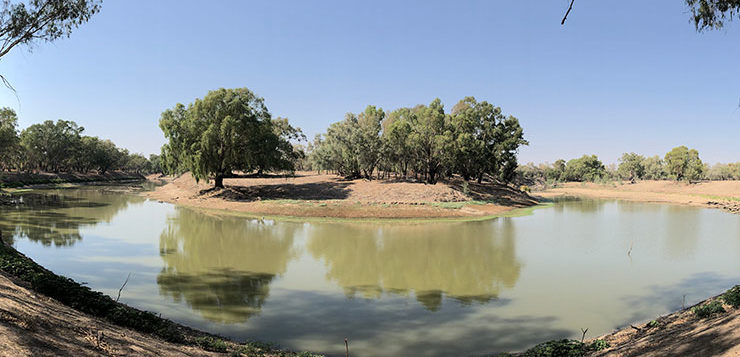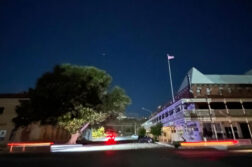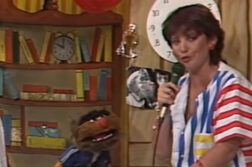In the latest in his series ‘The New Matilda Fantastical Historical Political Outback Tour – Aboriginal Edition’, NM editor Chris Graham visits the remote town of Bourke… and manages to escape with his life, and a slightly larger midriff.
The small, far north western NSW country town of Bourke is more dangerous than any country on earth. Literally, any country on earth.
Crime is so bad in Bourke – code for ‘Aboriginal people are so violent’ – that it’s worse than the lawless tribal areas of Pakistan; it’s more dangerous than the war zones of Iraq, Afghanistan and Syria; it’s not as safe as Gaza, under regular assault from Israel; it makes pockets of Africa, where Boko Haram slaughters people in the thousands, look like a cake walk.
This is obviously not my personal theory. Having passed through and stayed overnight in Bourke several times in the past month, I can tell you about the most dangerous things I encountered were two local businesses – Morrall’s Bakery in Mitchell Street, and Rice’s Back ‘O Bourke Cordials, one of the few remaining independent soft drink factories in the country. Both companies produce treats so tasty and sweet that I expect if I ever did live in Bourke, I’d develop diabetes within a month.
The theory actually belongs to Australia’s most highbrow publication, The Sydney Morning Herald, which published it as the lead story on the front page of its Saturday edition on February 2, 2013. The headline was “Bourke tops list: more dangerous than any country in the world”.
If you’re familiar with the Herald, you’ll know the Saturday rag is by far their largest circulating. So the story did a lot of damage to a town whose economy to some degree relies on tourism. And if you’re also familiar with Bourke, you would have found the story so staggeringly ridiculous that it was almost funny. Although, obviously, it wasn’t for the good folk in Bourke trying to eke out a living in a town ravaged by the tyranny of distance and drought.
For those not in the know, so remote is its location that Bourke is promoted locally as the ‘Gateway to the ‘real’ Outback’. It’s about a nine-hour drive from Sydney, and is situated on the northern reaches of the Darling River, with a population just shy of 2,000.
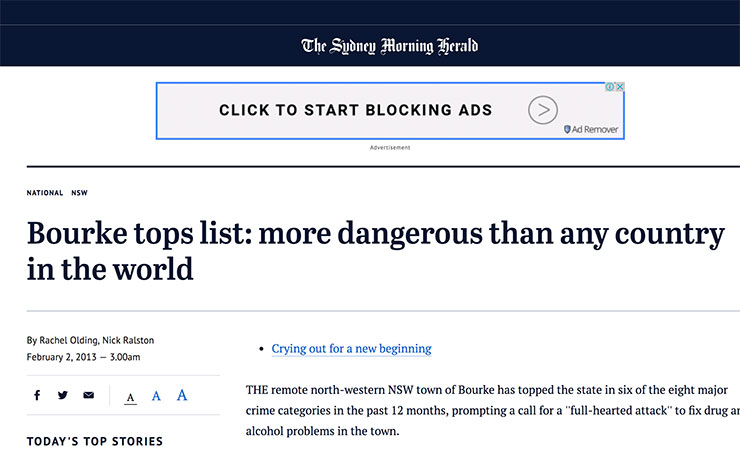
Like all Australian country towns, Bourke does have its share of dysfunction and violence. Indeed, on occasions, some categories of crime in Bourke have been the highest in the state. Bourke also happens to have a larger than average Aboriginal population, just over one third of the town. And that’s where the Herald story was heading – i.e. big Aboriginal population means big crime.
So is Aboriginality actually a predictor of crime? Well, sort of, but not in the way you might expect, and certainly not in the way that emboldens garden variety Australian rednecks, and journalists hunting for a headline.
Genetically, Aboriginal people are no more pre-disposed to criminality than any other racial group. But socially, Aboriginal people in Australia are much more likely to live in poverty, and poverty is directly related to crime levels. The poorer a town, the higher the crime – that’s true virtually the world over.
Thus towns with larger than average Aboriginal populations are generally poorer, and you don’t win elections in Australia lifting Aboriginal communities out of poverty. That’s how you lose elections. So Aboriginal towns, generally, have higher crime rates… although only the sorts of crime rates that mainstream media and politicians like to bang on about when circulation is down or there’s an election in the wind (for the other types of crime, google ‘Big Banks’, ‘parliamentary travel allowance abuse’ and ‘the clergy’).
And this is where the politics come in, and actually help feed the crime rate, and the fake news.
Thanks to Bourke’s larger than average Aboriginal population, the third largest employer in town is ‘Police Services’, a pretty remarkable statistic in its own right, and one surely worthy of a front-page splash in the Herald. There were 46 staff at the Bourke Police station in 2016, for a population of just 1,909. To put that in some context for you, that’s more than 11 times the state average – the NSW government employs more police and support staff in Bourke than it does doctors, nurses, health workers and high school teachers. [Author’s note: Since publication, I’ve re-visited Bourke, and this story – some of the staff based in Bourke service the broader region… more to come on this in a follow up yarn in June].
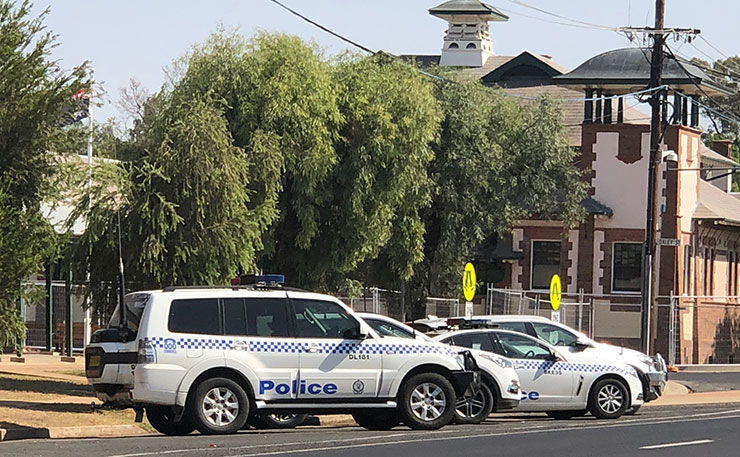
And no prizes for guessing what happens when you put more police in town. Just as crime follows poverty, more arrests follow more police. Thus, a community gets ‘over-policed’ and you end up with closed circuit television cameras in the main street, and – as was claimed to be the case in Bourke – cops paid to watch the cameras 24 hours a day.
At the time of the Herald’s misreporting, Bourke topped the state for ‘driving offences’. Locals say this was spurred on by police sitting in the local station sending car crews after anyone who drove up the main street in the early morning hours. It also had the highest rate of ‘breaching bail conditions’, which is directly related to higher levels of people going to court… for things like ‘driving offences’. It’s a self-perpetuating cycle and it helps explains why the crime rates at Bourke were so high. But did that make Bourke ‘most dangerous place on earth’?
Obviously not. It wasn’t even really the most dangerous place in New South Wales at the time – that honour belonged to the Sydney CBD. So how did the Herald get it so spectacularly wrong?
Well the answer is, it was deliberate. In ‘researching’ their story, the Herald was aware that the homicide rate in Bourke for the period they were interested in was zero. Frustratingly for Fairfax, no-one got murdered in Bourke in 2012.
So they left that category out of their calculation, and then pretended that the ‘height of danger’ was in fact assault and robbery, as opposed to getting your head cut off.
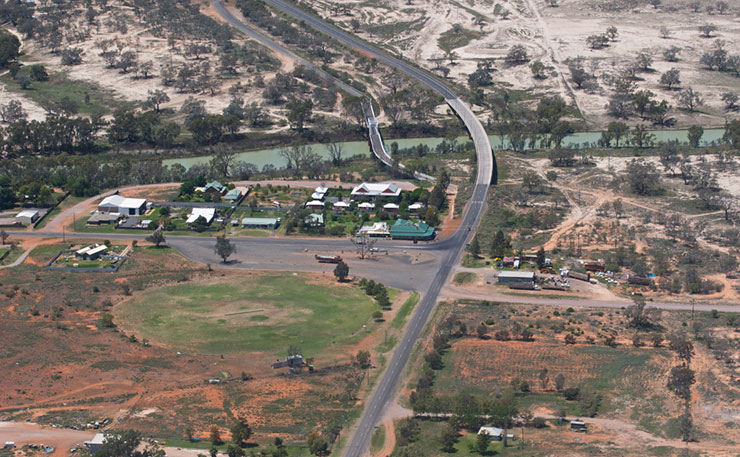
Bourke did have the highest rates per head of population in the state for robbery, assault and domestic violence at the time, but by way of example, the number of robberies – i.e. not the rate but the actual number of events – for the town in the period the Herald reported on was 5.
Yes, 5.
So the Herald took the rate, rather than actual robberies, and compared that to figures held by the United Nations for crime statistics from around the world.
My job has taken me to some of the world’s more violent places, and I’ve met the occasional vagabond on my travels. But I’m yet to bump into an official United Nations statistician studiously collecting data on, for example, the rates of murder, robbery and assault in war zones.
The fact is, we no more accurately know the actual crime rates of third world and war-torn countries than we know next week’s lottery numbers. To put not too fine a point on it, the story was a complete beat-up. The claim that Bourke is the most dangerous place on earth is clearly, demonstrably false. You can read a more comprehensive feature I wrote on the issue here in 2013, but, given the story was ‘broken’ by the Herald six years ago, why am I banging on about it now?
It’s partly because the ‘New Matilda Fantastical Historical Political Outback Tour – Aboriginal Edition’ has taken me through Bourke several times in the past month, on my way to and from Broken Hill. It’s also partly because the Herald has never acknowledged the story was complete bullshit, let alone apologised. And it’s partly because the Herald story remains online, and continues to do serious damage to the reputation of Bourke. Indeed, if you google the phrase ‘Bourke crime’, the Herald’s fiction is the second hit.
But it’s mostly because the town of Bourke today is a model of what a small town can achieve when black and white start working together.
In a beautiful twist of fate, the first hit you get when you google ‘Bourke crime’ is also a story from a mainstream media outlet, but it takes a vastly different approach, noting that crime in Bourke has nose-dived over the past few years, courtesy of a community-led initiative aimed at ‘justice re-investment’ in the town.
Most satisfyingly, that story is written by an Aboriginal journalist, Lorena Allam, someone with ‘skin in the game’ and a level of accountability to the Aboriginal community. Unlike journalists from publications like the Herald, who are just trying to get their by-line on the front page.
It was mission accomplished in this case, but if Herald journos are still looking for fresh data yarns, they should take a look at crimes rates – particularly alcohol-related assaults – in the inner-west suburb of Pyrmont, a razzle-dazzle harbourside community in Sydney which includes the plush offices of The Sydney Morning Herald.
Pyrmont also happens to be home to the Star City Casino, Sydney’s largest entertainment venue. Alcohol-related assaults increased after the NSW Government brought in the ‘lockout laws’. They were introduced in 2014 after intense lobbying from… you guessed it, The Sydney Morning Herald, banging the fear drum of crime rates. I’ll bring you that story – ‘Who Really Killed Sydney?’ – in the coming weeks.
In the meantime, I’m passing back through Bourke in another week or so. I’m trying to get off sugar. Wish me luck.
* You can follow Chris’ journey, or send him story suggestions by sending him an email, or here on Facebook, and here on Twitter.
Donate To New Matilda
New Matilda is a small, independent media outlet. We survive through reader contributions, and never losing a lawsuit. If you got something from this article, giving something back helps us to continue speaking truth to power. Every little bit counts.

